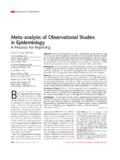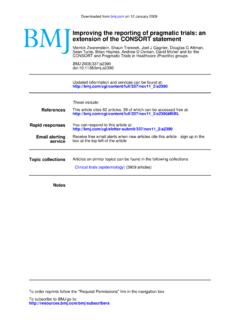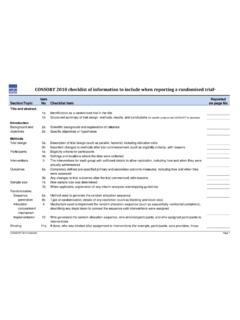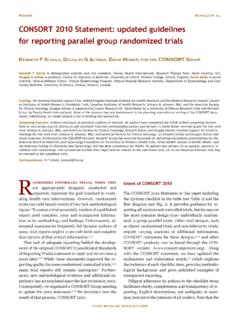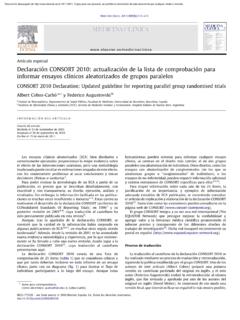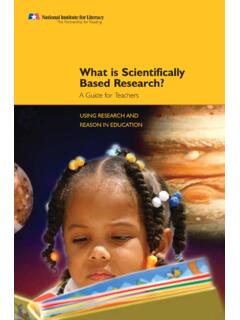Transcription of research methods & reporting - CONSORT Statement
1 BMJ | online FiRST | 1 of 28research methods & reporting The whole of medicine depends on the transparent report ing of clinical trials. 1 Well designed and properly executed randomised con trolled trials (RCTs) provide the most reliable evidence on the efficacy of healthcare interventions, but trials with inadequate methods are associated with bias, especially exaggerated treatment 5 Biased results from poorly designed and reported trials can mislead decision making in health care at all levels, from treatment decisions for a patient to formulation of national public health appraisal of the quality of clinical trials is possible only if the design, conduct, and analysis of RCTs are thor oughly and accurately described in the report.
2 Far from being transparent, the reporting of RCTs is often incomplete,6 9 com pounding problems arising from poor 15incomplete and inaccurate reportingMany reviews have documented deficiencies in reports of clinical trials. For example, information on the method used in a trial to assign participants to comparison groups was reported in only 21% of 519 trial reports indexed in PubMed in 2000,16 and only 34% of 616 reports indexed in Similarly, only 45% of trial reports indexed in PubMed in 200016 and 53% in 200617 defined a pri mary end point, and only 27% in 2000 and 45% in 2006 reported a sample size calculation. reporting is not only often incomplete but also sometimes inaccurate.
3 Of 119 reports stating that all participants were included in the analysis in the groups to which they were originally assigned (intention to treat analysis), 15 (13%) excluded patients or did not analyse all patients as Many other reviews have found that inadequate reporting is com mon in specialty journals16 19 and journals published in languages other than 21 Proper randomisation reduces selection bias at trial entry and is the crucial component of high quality Successful randomisation hinges on two steps: generation of an unpredictable allocation sequence and concealment of this sequence from the investigators enrolling partici pants (see box 1).2 23 Unfortunately, despite that central role, reporting of the methods used for allocation of participants to inter ventions is also generally inadequate.
4 For example, 5% of 206 reports of supposed RCTs in obstetrics and gynae cology journals described studies that were not truly ran This estimate is conservative, as most reports do not at present provide adequate information about the method of 23 30 331 Ottawa methods Centre, Clinical Epidemiology Program, Ottawa Hospital research Institute, Ottawa Hospital, Ottawa, Ontario, Canada, K1H 8L62 Centre for Statistics in Medicine, University of Oxford, Wolfson College, Oxford 3 Family Health International, research Triangle Park, NC 27709, USA4UK Knowledge and Encounter research Unit, Mayo Clinic, Rochester, MN, USA5 The Nordic Cochrane Centre, Rigshospitalet, Blegdamsvej 9, Copenhagen, Denmark6 McMaster University Health Sciences Centre, Hamilton, Canada 7 Medical Statistics Unit, London School of Hygiene and Tropical Medicine, London8 Institute of Social and Preventive Medicine (ISPM), University of Bern, SwitzerlandCorrespondence to: D Moher 8 February 2010 Cite this as: BMJ 2010.
5 340:c869doi: 2010 explanation and elaboration: updated guidelines for reporting parallel group randomised trialsDavid Moher,1 Sally Hopewell,2 Kenneth F Schulz,3 Victor Montori,4 Peter C G tzsche,5 P J Devereaux,6 Diana Elbourne,7 Matthias Egger,8 Douglas G Altman2abstractOverwhelming evidence shows the quality of reporting of randomised controlled trials (RCTs) is not optimal. Without transparent reporting , readers cannot judge the reliability and validity of trial findings nor extract information for systematic reviews. Recent methodological analyses indicate that inadequate reporting and design are associated with biased estimates of treatment effects. Such systematic error is seriously damaging to RCTs, which are considered the gold standard for evaluating interventions because of their ability to minimise or avoid group of scientists and editors developed the CONSORT (Consolidated Standards of reporting Trials) Statement to improve the quality of reporting of RCTs.
6 It was first published in 1996 and updated in 2001. The Statement consists of a checklist and flow diagram that authors can use for reporting an RCT. Many leading medical journals and major international editorial groups have endorsed the CONSORT Statement . The Statement facilitates critical appraisal and interpretation of the 2001 CONSORT revision, it became clear that explanation and elaboration of the principles underlying the CONSORT Statement would help investigators and others to write or appraise trial reports. A CONSORT explanation and elaboration article was published in 2001 alongside the 2001 version of the CONSORT an expert meeting in January 2007, the CONSORT Statement has been further revised and is published as the CONSORT 2010 Statement .
7 This update improves the wording and clarity of the previous checklist and incorporates recommendations related to topics that have only recently received recognition, such as selective outcome reporting explanatory and elaboration document intended to enhance the use, understanding, and dissemination of the CONSORT Statement has also been extensively revised. It presents the meaning and rationale for each new and updated checklist item providing examples of good reporting and, where possible, references to relevant empirical studies. Several examples of flow diagrams are CONSORT 2010 Statement , this revised explanatory and elaboration document, and the associated website ( ) should be helpful resources to improve reporting of randomised | online FiRST | 2 of 28research methods & reportingimproving the reporting of rcts: the CONSORT statementDerSimonian and colleagues suggested that editors could greatly improve the reporting of clinical trials by providing authors with a list of items that they expected to be strictly reported.
8 34 Early in the 1990s, two groups of journal edi tors, trialists, and methodologists independently published recommendations on the reporting of 36 In a subse quent editorial, Rennie urged the two groups to meet and develop a common set of recommendations 37; the outcome was the CONSORT Statement (Consolidated Standards of reporting Trials).38 The CONSORT Statement (or simply CONSORT ) comprises a checklist of essential items that should be included in reports of RCTs and a diagram for documenting the flow of participants through a trial. It is aimed at primary reports of RCTs with two group, parallel designs. Most of CONSORT is also relevant to a wider class of trial designs, such as non inferiority, equivalence , factorial, cluster, and crossover tri als.
9 Extensions to the CONSORT checklist for reporting trials with some of these designs have been published,39 41 as have those for reporting certain types of data (harms 42), types of interventions (non pharmacological treatments 43, herbal interventions44), and objective of CONSORT is to provide guidance to authors about how to improve the reporting of their trials. Trial reports need be clear, complete, and transparent. Readers, peer reviewers, and editors can also use CONSORT to help them critically appraise and interpret reports of RCTs. However, CONSORT was not meant to be used as a quality assessment instrument. Rather, the content of CONSORT focuses on items related to the internal and external validity of trials.
10 Many items not explicitly mentioned in CONSORT should also be included in a report, such as information about approval by an ethics committee, obtaining informed consent from par ticipants, and, where relevant, existence of a data safety and monitoring committee. In addition, any other aspects of a trial that are mentioned should be properly reported, such as information pertinent to cost effectiveness 48 Since its publication in 1996, CONSORT has been sup ported by more than 400 journals ( ) and several editorial groups, such as the International Committee of Medical Journal The introduction of CONSORT within journals is associated with improved quality of reports of 50 51 However, CONSORT is an ongoing initiative, and the CONSORT Statement is revised CONSORT was last revised nine years ago, in 54 Since then the evidence base to inform CONSORT has grown considerably.

